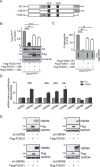FOXO1 controls protein synthesis and transcript abundance of mutant polyglutamine proteins, preventing protein aggregation
- PMID: 33822053
- PMCID: PMC8170844
- DOI: 10.1093/hmg/ddab095
FOXO1 controls protein synthesis and transcript abundance of mutant polyglutamine proteins, preventing protein aggregation
Abstract
FOXO1, a transcription factor downstream of the insulin/insulin like growth factor axis, has been linked to protein degradation. Elevated expression of FOXO orthologs can also prevent the aggregation of cytosine adenine guanine (CAG)-repeat disease causing polyglutamine (polyQ) proteins but whether FOXO1 targets mutant proteins for degradation is unclear. Here, we show that increased expression of FOXO1 prevents toxic polyQ aggregation in human cells while reducing FOXO1 levels has the opposite effect and accelerates it. Although FOXO1 indeed stimulates autophagy, its effect on polyQ aggregation is independent of autophagy, ubiquitin-proteasome system (UPS) mediated protein degradation and is not due to a change in mutant polyQ protein turnover. Instead, FOXO1 specifically downregulates protein synthesis rates from expanded pathogenic CAG repeat transcripts. FOXO1 orchestrates a change in the composition of proteins that occupy mutant expanded CAG transcripts, including the recruitment of IGF2BP3. This mRNA binding protein enables a FOXO1 driven decrease in pathogenic expanded CAG transcript- and protein levels, thereby reducing the initiation of amyloidogenesis. Our data thus demonstrate that FOXO1 not only preserves protein homeostasis at multiple levels, but also reduces the accumulation of aberrant RNA species that may co-contribute to the toxicity in CAG-repeat diseases.
© The Author(s) 2021. Published by Oxford University Press. All rights reserved. For Permissions, please email: journals.permissions@oup.com.
Figures





Similar articles
-
Molecular insights into the interaction of CAG trinucleotide RNA repeats with nucleolin and its implication in polyglutamine diseases.Nucleic Acids Res. 2022 Jul 22;50(13):7655-7668. doi: 10.1093/nar/gkac532. Nucleic Acids Res. 2022. PMID: 35776134 Free PMC article.
-
Increased aggregation of polyleucine compared with that of polyglutamine in dentatorubral-pallidoluysian atrophy protein.Neurosci Lett. 2013 Sep 27;552:156-61. doi: 10.1016/j.neulet.2013.07.043. Epub 2013 Aug 7. Neurosci Lett. 2013. PMID: 23933208
-
Targeting Ubiquitin Proteasome Pathway with Traditional Chinese Medicine for Treatment of Spinocerebellar Ataxia Type 3.Am J Chin Med. 2019;47(1):63-95. doi: 10.1142/S0192415X19500046. Epub 2019 Jan 7. Am J Chin Med. 2019. PMID: 30612452
-
Mechanisms of RNA-induced toxicity in CAG repeat disorders.Cell Death Dis. 2013 Aug 1;4(8):e752. doi: 10.1038/cddis.2013.276. Cell Death Dis. 2013. PMID: 23907466 Free PMC article. Review.
-
Repeat associated non-ATG translation initiation: one DNA, two transcripts, seven reading frames, potentially nine toxic entities!PLoS Genet. 2011 Mar;7(3):e1002018. doi: 10.1371/journal.pgen.1002018. Epub 2011 Mar 10. PLoS Genet. 2011. PMID: 21423665 Free PMC article. Review.
Cited by
-
Specific Deletions of Chromosomes 3p, 5q, 13q, and 21q among Patients with G2 Grade of Non-Small Cell Lung Cancer.Int J Mol Sci. 2024 Aug 8;25(16):8642. doi: 10.3390/ijms25168642. Int J Mol Sci. 2024. PMID: 39201328 Free PMC article.
-
Embryonic Leucine Promotes Early Postnatal Growth via mTOR Signalling in Japanese Quails.Animals (Basel). 2024 Sep 6;14(17):2596. doi: 10.3390/ani14172596. Animals (Basel). 2024. PMID: 39272381 Free PMC article.
References
-
- Balch, W.E., Morimoto, R.I., Dillin, A. et al. (2008) Adapting proteostasis for disease intervention. Science (80-.)., 319, 916–919. - PubMed
-
- Kampinga, H.H. and Bergink, S. (2016) Heat shock proteins as potential targets for protective strategies in neurodegeneration. Lancet Neurol., 15, 748–759. - PubMed
Publication types
MeSH terms
Substances
LinkOut - more resources
Full Text Sources
Other Literature Sources
Research Materials
Miscellaneous

